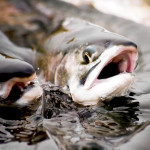 While fish may be unable to vocalize their pain in ways that humans can recognize, the scientific consensus is clear: fish feel pain, much like we do. They’re smart, have good memories, form complex social relationships, and some even use tools.
While fish may be unable to vocalize their pain in ways that humans can recognize, the scientific consensus is clear: fish feel pain, much like we do. They’re smart, have good memories, form complex social relationships, and some even use tools.
Sadly, overfishing is putting many species on the verge of extinction. The number of aquatic animals killed for human consumption is not known — in the U.S., fish killed for food are not counted as individuals; they’re tracked by total pounds. Annual estimates, however, exceed 15 billion animals killed. Commercial fishers use trawling nets that can be miles long, catching thousands of fish at a time, along with countless non-target animals referred to as “by-catch” which often includes dolphins, turtles, whales, sharks, birds and seals.
In 2019, we released the first-ever undercover exposé of salmon aquaculture in the U.S. Our investigator worked inside Cooke Aquaculture in Bingham, Maine, exposing senseless violence against these sentient animals at an industrial Atlantic salmon hatchery supplying Martha Stewart’s new True North Seafood line.
Fish factory farms, collectively known as aquaculture, are sadly on the rise. Intensively confined in overcrowded cages in the sea, these sentient beings live in filthy conditions, abused and pumped full of antibiotics.Their lives are filled with misery and often end by being sliced open with a knife while still fully conscious or slammed against the concrete.
